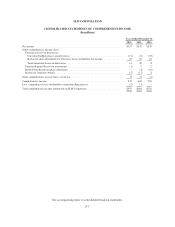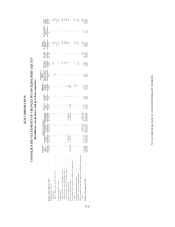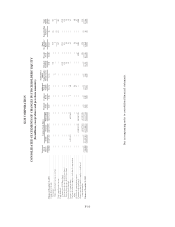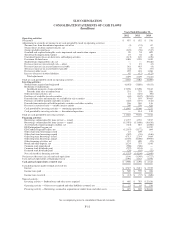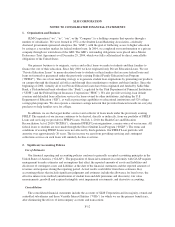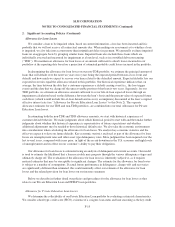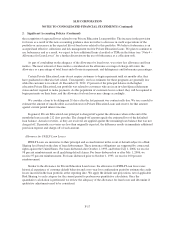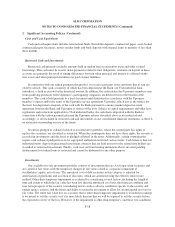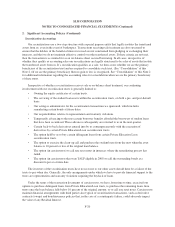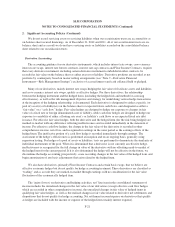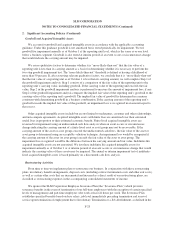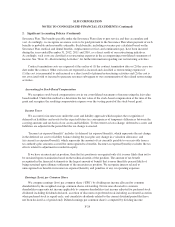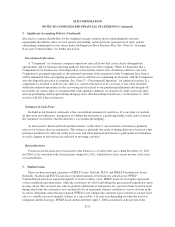Sallie Mae 2012 Annual Report Download - page 125
Download and view the complete annual report
Please find page 125 of the 2012 Sallie Mae annual report below. You can navigate through the pages in the report by either clicking on the pages listed below, or by using the keyword search tool below to find specific information within the annual report.SLM CORPORATION
NOTES TO CONSOLIDATED FINANCIAL STATEMENTS (Continued)
2. Significant Accounting Policies (Continued)
Allowance for Loan Losses
We consider a loan to be impaired when, based on current information, a loss has been incurred and it is
probable that we will not receive all contractual amounts due. When making our assessment as to whether a loan
is impaired, we also take into account more than insignificant delays in payment. We generally evaluate impaired
loans on an aggregate basis by grouping similar loans. Impaired loans also include those loans which are
individually assessed and measured for impairment at a loan level, such as in a troubled debt restructuring
(“TDR”). We maintain an allowance for loan losses at an amount sufficient to absorb losses incurred in our
portfolios at the reporting date based on a projection of estimated probable credit losses incurred in the portfolio.
In determining the allowance for loan losses on our non-TDR portfolio, we estimate the principal amount of
loans that will default over the next two years (two years being the expected period between a loss event and
default) and how much we expect to recover over time related to the defaulted amount. Expected defaults less our
expected recoveries equal the allowance related to this portfolio. Our historical experience indicates that, on
average, the time between the date that a customer experiences a default causing event (i.e., the loss trigger
event) and the date that we charge off the unrecoverable portion of that loan is two years. Separately, for our
TDR portfolio, we estimate an allowance amount sufficient to cover life-of-loan expected losses through an
impairment calculation based on the difference between the loan’s basis and the present value of expected future
cash flows (which would include life-of-loan default and recovery assumptions) discounted at the loan’s original
effective interest rate (see “Allowance for Private Education Loan Losses” to this Note 2). The separate
allowance estimates for our TDR and non-TDR portfolios, are combined into our total Allowance for Private
Education Loan losses.
In estimating both the non-TDR and TDR allowance amounts, we start with historical experience of
customer default behavior. We make judgments about which historical period to start with and then make further
judgments about whether that historical experience is representative of future expectations and whether
additional adjustments may be needed to those historical default rates. We also take the economic environment
into consideration when calculating the allowance for loan losses. We analyze key economic statistics and the
effect we expect it to have on future defaults. Key economic statistics analyzed as part of the allowance for loan
losses are unemployment rates and other asset type delinquency rates. More judgment has been required over the
last several years, compared with years prior, in light of the recent downturn in the U.S. economy and high levels
of unemployment and its effect on our customer’s ability to pay their obligations.
Our allowance for loan losses is estimated using an analysis of delinquent and current accounts. Our model
is used to estimate the likelihood that a loan receivable may progress through the various delinquency stages and
ultimately charge off. The evaluation of the allowance for loan losses is inherently subjective, as it requires
material estimates that may be susceptible to significant changes. The estimate for the allowance for loan losses
is subject to a number of assumptions. If actual future performance in delinquency, charge-offs and recoveries
are significantly different than estimated, this could materially affect our estimate of the allowance for loan
losses and the related provision for loan losses on our income statement.
Below we describe in further detail our policies and procedures for the allowance for loan losses as they
relate to our Private Education Loan and FFELP Loan portfolios.
Allowance for Private Education Loan Losses
We determine the collectability of our Private Education Loan portfolio by evaluating certain risk characteristics.
We consider school type, credit score (FICO), existence of a cosigner, loan status and loan seasoning as the key credit
F-15




